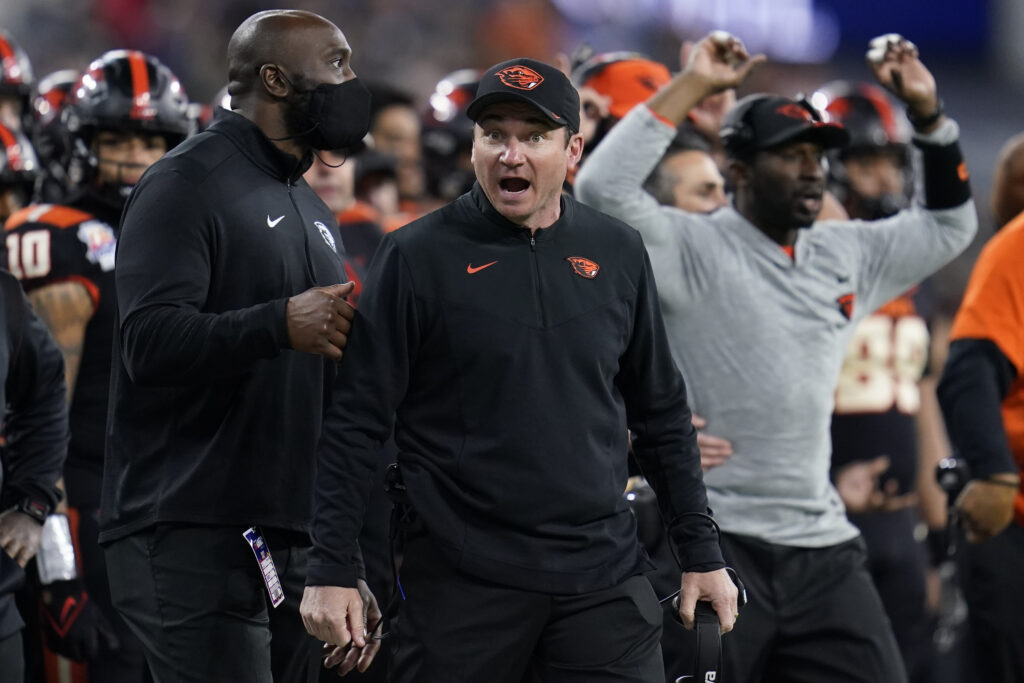Send questions to pac12hotline@bayareanewsgroup.com and include ‘mailbag’ in the subject line. Or hit me on Twitter: @WilnerHotline
Please note: Some questions have been edited for clarity and brevity.
This question presupposes some sort of merger with the Mountain West: What odds would you place on Washington State or Oregon State making the playoff before Washington or Oregon? — @CougRob
The Hotline loves hypothetical questions that provide an outlet for explaining an underlying process, and no process is more important to college football than the playoff.
When the CFP expands to 12 teams next season (2024), the six highest-ranked conference championships will receive automatic bids. Why six? Because there are five power conferences. (In NCAA-speak, they are called the Autonomy Five.) The extra automatic bid creates access for the best team in the so-called Group of Five leagues and avoids any antitrust issues.
But that format is only in place for the first two years of the expanded playoff (the 2024 and 2025 seasons). After that, the current media contract ends and everything will be reconsidered.
We expect the SEC and Big Ten to use the collapse of the Pac-12 as a means of trimming the number of automatic bids (from six to five) and adding an at-large berth (from six to seven), clearing an extra spot for their array of football powerhouses.
Why five automatic bids? To provide access for the highest-ranked conference champion outside the power leagues. In the era of the Power Five, the CFP power brokers created six automatic bids. When it becomes the Power Four, they will have five automatic bids.
All of which means …
The Mountain West champion will have an excellent chance to claim an automatic bid.
Its competition for that slot would consist of the winners of the Sun Belt, Mid-American, Conference USA and American, which will be greatly depleted by the loss of Cincinnati, Houston and UCF.
In other words, if WSU or OSU produced a one- or two-loss season in the Mountain West, the playoff could very well be in play.
Meanwhile, Oregon and Washington would need to either win the rugged Big Ten or finish in the top three or four and hope for an at-large spot.
We cannot guarantee the CFP selection formula in the next contract cycle (starting with the 2026 season) will have five automatic bids, but it’s a reasonable assumption at this point. If they block access for the other leagues, a lawsuit could result.
In no way, shape or form is the Hotline attempting to minimize the impact of the Pac-12’s collapse on the WSU and OSU athletic departments, their athletes or their fans. It’s nothing short of devastating.
But the path into the playoff from a revamped Mountain West seemingly is more reasonable than it would be through an intact Pac-12, which likely would be in line for a single berth.
Is there a path for Oregon State and Washington State to push for a merger with the Mountain West without Stanford (and likely Cal)? — @busaf95
If the Cardinal and Bears are not involved, a merger seems unlikely. Why would the Mountain West members agree? They would hold the leverage (and the votes).
Instead, WSU and OSU would simply request invitations to join in time for the 2024 season.
Those requests assuredly would be granted, and the Mountain West would move forward with 14 football schools and 13 basketball schools. (Hawaii participates in the Big West in all sports except football.)
The unknown piece in that scenario: Would the Beavers and Cougars enter with full revenue shares?
The Mountain West distributes about $4.75 million annually to each member through its broadcast contracts with Fox and CBS. The current schools won’t accept less money to add schools, so the networks seemingly would need to fund the expansion — but only for two contract years.
The current deal reportedly expires in the summer of 2026, meaning negotiations on a renewal would begin in late ’24 or early ’25.
WSU president Kirk Schulz and athletic director Pat Chun appear to be really smart, savvy guys. Were they really taken by surprise by Oregon and Washington not signing the grant-of-rights last Friday? And why didn’t they (like seemingly everyone else) have a Plan B? — @Smittytheclownn
Yes and no. They knew all along that collapse was a possible outcome for the Pac-12. But in the final hours, late on Thursday, Aug. 3, it appeared the nine schools were prepared to sign their grant-of-rights and move forward together. So in the moment, yes, there was probably some level of surprise.
As for the lack of any Plan B, well, the Cougars couldn’t create an optimal landing spot out of thin air.
Unlike Washington and Oregon, they didn’t have an invitation to the Big Ten.
Unlike Utah and the Arizona schools, they didn’t have a safety net courtesy of the Big 12.
They knew all along that the Mountain West would be available. And that’s still the case.
What’s the real reason Stanford and Cal didn’t receive invitations to the Big Ten? It makes the most sense for the Big Ten. A great pod of Pacific Time Zone teams would help ease much of the travel burden. — @SJVst
The “real” reason is the only reason: Fox.
Were the decision left solely to the Big Ten presidents, the Bay Area school likely would have invitations already.
But the Big Ten schools won’t support any expansion if the process results in reduced media revenue, so new cash is required. And that means the conference’s media overlord must find the cash, just as it did with Oregon and Washington.
Fox believed the Pacific Northwest schools were worth $375 million (at least) over six years. It did not believe the Bay Area schools were a worthwhile investment at that price.
Is there a number that works? Perhaps. We should know in the next few weeks.
As for your second question, the answer is clear: Yes, adding the Bay Area schools would greatly benefit Olympic sports athletes on all the Big Ten campuses.
A six-team western arm would create more intra-regional conference games, thereby reducing the need to travel to Big Ten territory.
And the reverse is also true. Any increase in games played within the West Coast pod would limit the number of cross-country trips for the Midwestern schools.
For athletes in the Olympic sports, the only thing that makes less sense than USC and UCLA being in the Big Ten alone is USC, UCLA, Oregon and Washington being in the Big Ten without Stanford and Cal.
How was Stanford left behind? It wasn’t that long ago when Stanford was regularly a top team in football. How did it fall so hard and whose fault is it? — @Lionsmaul
The on-field downturn resulted from poor recruiting, substandard coaching and the malaise that often follows successful runs. Also, Stanford’s academic standards are ill-suited for the transfer portal era.
But make no mistake: If this realignment wave had unfolded in the mid-2010s, Stanford would have been a no-brainer for the Big Ten — and for Fox.
Timing is everything in realignment. For Stanford, the timing was terrible.
Is it possible that the Big Ten is thinking it eventually would want Cal and Stanford? And the conference is forced to decide to grab them before they jump to the ACC? — @bentMV
We can only speculate about the long game. Could the Big Ten have eyes on the Bay Area schools for its next contract cycle, in 2030? Perhaps.
But Fox could very well focus on expanding into the southeast to acquire college football properties in Florida.
The Hotline believes Stanford and Cal have a better chance of gaining entry into the Big Ten now if they have leverage, in the form of standing invitations to the ACC.
Fox came up with the cash for Oregon and UW only when they had a contract offer from the Pac-12.
Perhaps it would do the same if the Bears and Cardinal were on the brink of entering the ACC.
They’re close. Four schools reportedly oppose invitations: Clemson, Florida State, North Carolina and N.C. State. If just one relents, the Bay Area schools are in. But that foursome will be a difficult bloc to break.
Do you think the University of California regents regret approving UCLA’s move to the Big Ten now that Cal has been left out to dry? — @scottwmcdonough
We cannot speak for the regents, but that’s a reasonable assumption for the 11 members of the board who voted in favor of UCLA’s move. (Five voted against.)
And don’t forget about the Berkeley tax, the so-called Cal-imony.
The regents retained the authority to force UCLA to subsidize the Bears, with payments ranging from as little as $2 million annually to as much as $10 million. The exact total would be based “on the best available information on projected revenues for both campuses.”
If Cal doesn’t gain membership in the ACC or Big Ten, its revenue will crater and you can bet the regents will impose the top end of that subsidy.
UCLA has a lot riding on Cal’s landing spot and, we presume, is maneuvering to get the Bears into either the ACC or Big Ten.
Assuming Cal and Stanford leave, why wouldn’t WSU and OSU each take $200 million in Pac-12 assets and spread that over six or seven years as Independents and try to get in a conference when the next domino falls, or buy time until they can reform a version of the Pac-12? — @DevinOssman
The amount of cash available for any combination of the four remaining schools is unknown.
I would be surprised if they had access to hundreds of millions of dollars in revenue generated during the 2023-24 sports season. That scenario becomes reality only if they are allowed to withhold all distributions to the eight outgoing schools.
The lawyers are digging into that issue, and several others, according to Washington State president Kirk Schulz.
If the Beavers, Cougars, Cal and Stanford choose to remain in the Pac-12 and rebuild it, what’s the likelihood they could strike a media deal that would be adequate financially? — Dennis S.
Depends on how you define adequate.
The Hotline teamed up with an expert in sports media valuations to determine a reasonable revenue range for any reconstructed Pac-12 featuring teams from the Mountain West and American conferences.
The bottom line: The reformed Pac-8 or Pac-10 could be worth substantially more than either of those leagues. But there’s no scenario in which the rebuilt entity approaches the revenue that would have flowed with an intact Pac-12.
Ultimately, do you think the Pac-12 was unable to negotiate a media deal because the conference leadership and/or the schools incorrectly gauged their media value? — @Jalex0077
Both were true. The schools had an inflated sense of their media value, with multiple presidents pushing for $50 million paychecks from ESPN.
At the same time, commissioner George Kliavkoff was unable to convince them otherwise and create realistic expectations.
How many episodes will ESPN need for the “30 for 30” on the media negotiations and demise of the conference? — @MarcSheehan006
The march to collapse began in 2011 with the creation of the Pac-12 Networks and continued unabated for 12 years, as we outlined last week.
Essentially, ESPN would need a ’60 for 60.’
Which of the teams that have left the Pac-12 do you think you’ll stop covering? — @gohuskies1978
None of them.
The Hotline covered the schools and the issues that matter to them long before “Pac-12” was added to the name of our operation a few years ago. That won’t change with new conference affiliations.
If needed, we just change the name to WilnerHotline.com — that’s also my Twitter handle — and roll on.
As always, we are deeply grateful for the support and loyalty from the legions of readers.
*** Send suggestions, comments and tips (confidentiality guaranteed) to pac12hotline@bayareanewsgroup.com or call 408-920-5716
*** Follow me on Twitter: @WilnerHotline
*** Pac-12 Hotline is not endorsed or sponsored by the Pac-12 Conference, and the views expressed herein do not necessarily reflect the views of the Conference.
Related posts:

(AP Photo/Darryl Webb)
Pac-12 survival: What’s next for Oregon State, Washington State, Stanford and Cal after mass exodus to Big Ten, Big 12
Washington State quarterback Cameron Ward (1) (AP Photo/Andy Manis)
Mailbag: WSU and OSU link arms as their playoff path widens, Beavers and Cougars will have a better chance to reach the CFP despite carnage, more
Washington State quarterback Cameron Ward (1) (AP Photo/Andy Manis)
Wilner Hotline – Saturday Night Five: Along come the Cougars, OSU’s big win, USC’s takeaways, collecting wins (except in Boulder) Pac-12 chaos: Judge sides with WSU and OSU, brings board business to temporary halt
Pac-12 chaos: Judge sides with WSU and OSU, brings board business to temporary halt
Jon Wilner
Jon Wilner has been covering college sports for decades and is an AP top-25 football and basketball voter as well as a Heisman Trophy voter. He was named Beat Writer of the Year in 2013 by the Football Writers Association of America for his coverage of the Pac-12, won first place for feature writing in 2016 in the Associated Press Sports Editors writing contest and is a five-time APSE honoree.
